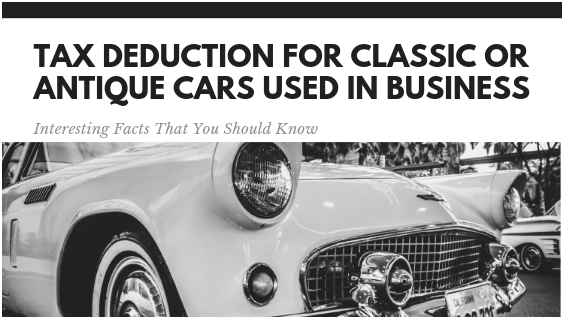
Are you thinking of using a classic or antique car for your business?
If you are, did you know that you can deduct it the same way as any car that you use in your business?
Yes, you can actually deduct classic or antique cars used in business as long as you are aware of a few facts on how it works.
To better understand tax deduction for classic or antique cars used in business, here are seven things that you should know.
Presenting Classic or Antique Car as a Write-Off
To start with, the court states that to deduct the classic or antique car, it must meet the following criteria:
- the car must be of a type that’s subject to wear and tear, decay, decline, or exhaustion; and
- the car must be used in your trade or business.
Since you are thinking of using a classic or antique car for your business, over time, it will definitely undergo wear and tear, decay, and exhaustion.
Understanding the Law
To better grasp the technicalities behind the deduction, it would be helpful to familiarize yourself with the laws behind them.
Previously, laws made it difficult for a business-owner to write-off a classic or antique car. However, in 1981, lawmakers simplified depreciation deductions and removed the requirements of “salvage value” and “estimated useful life”.
These changes made it possible for taxpayers Brian P. Liddle and Richard Simon to win tax deductions for rapidly appreciating antique and rare violins and violin bows which were coveted by collectors.
In their case, the courts noted that the violins and bows may not be depreciable under the pre-1981 law. However, the depreciation simplification in the 1981 law enabled the deductions for antique violins and bows that were used by musicians.
Dealing with the IRS
The IRS has stated that they will not follow the Liddle and Simon cases. It was also said that the IRS wants to bring the case in a different course for the possibility of having a different result. This will allow them to appeal antique depreciation to the Supreme Court with the goal of getting the court to rule that antiques are no longer deductible.
Going back to the cases of Liddle and Simon, the taxpayers won their cases based on a 1981 law that created the term “recovery property” as a replacement for the term “depreciation.”
Although a 1986 law deleted the term “recovery property” from Section 168 depreciation, the court noted in a different case that the change has no impact in the favorable results given to antique depreciation in Liddle and Simon.
In another court case that involved post-1986 law and that triggered the IRS Action on Decision, the court stated that it would follow Liddle and Simon. As a result, if ( insert client name here ) could show that the exotic automobiles he wanted to depreciate were subject to exhaustion, wear and tear, or obsolescence, he could then depreciate them.
This means that when it comes to dealing with the IRS, you have a defense given that the Liddle and Simon cases have paved the way for antiques to be depreciable.
Conclusion
Understanding how the tax deduction for classic or antique cars used in business works is especially helpful when it comes to weighing the benefits of using a new car or a classic one.
Remember, an antique car may incur more maintenance cost than a brand new car but given a few years, a classic car will be much more valuable. So, go ahead, deduct your priced antique car and go to work in style.

